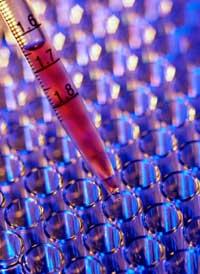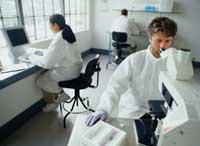The prions, the unsolved mystery
2006/03/05 Rementeria Argote, Nagore - Elhuyar Zientziaren Komunikazioa

Prion is a protein that produces diseases like the craziest cow. Prions are actually most of the cells of the animal body (the most abundant in neurons), but they still do not know what their function is. In fact, it is not possible for the body to keep the prions if they only serve to cause evil. They must have some function. But the role of prions is a mystery.
First clarifications
Thus, researchers seek the function of prions. According to one study, it may have to do with memory: it seems to help stabilize synapse between neurons. Consequently, it may be associated with the molecular mechanism of memory. However, this research has not revealed the mystery of prions, it has only given a small explanation.
Another study related to the role of prions has just been published. According to this, prions have to do with stem cell division. The discovery has been surprised at the Whitehead Biomedical Research Institute in Cambridge. In fact, the research, in essence, had nothing to do with prions, but sought the continuous division of stem cells. Carefully observing the division, it was observed that prions were expressed in large quantities. They continued to investigate and found that prion-expressing cells are more likely to survive.

Therefore, prions also appear in stem cell division. But that also does not explain what the function of prions is. At the moment they don't know what the prions are for.
The Second Mystery
Prions have more hidden areas. For example, for the extension of prion-related diseases, an infectious prion turns normal prions into infectious. Well, they don't even know how it does. Apparently, the common prion (the one we have in the body and the one that does not generate disease) and the infectious prion (the one that has been eaten in contaminated beef, for example) are the same (they have the same sequence of amino acids). The difference is in the three-dimensional structure. The simple prion is mainly helical, consists of helical structures, and the cause of the disease has a laminar structure, is formed by sheets.

In short, the infectious prion causes normal prions to also acquire the form of lamina, stack and form the so-called amyloid plates. All of this occurs mainly inside brain neurons. Because of these plaques, neurons cannot function and die.
This is the mechanism that prions follow to produce diseases. In general, diseases caused by prions are called transmissible spongiform encephalopathies: mad cow disease in cattle, Creutzfeldt-Jakob in men and women, scrapie in sheep... Everyone has the same basis. Therefore, if the mechanism is better known, the vaccine will be more easily sought to protect itself from these diseases or treatment to cure them. At the moment, the road is quite dark, but research will clarify it.
Published in 7K.




